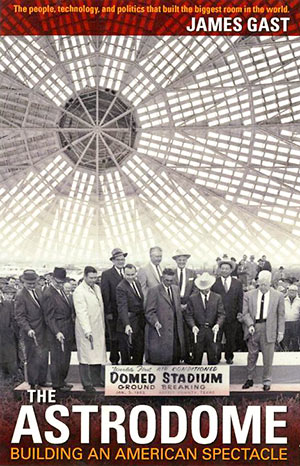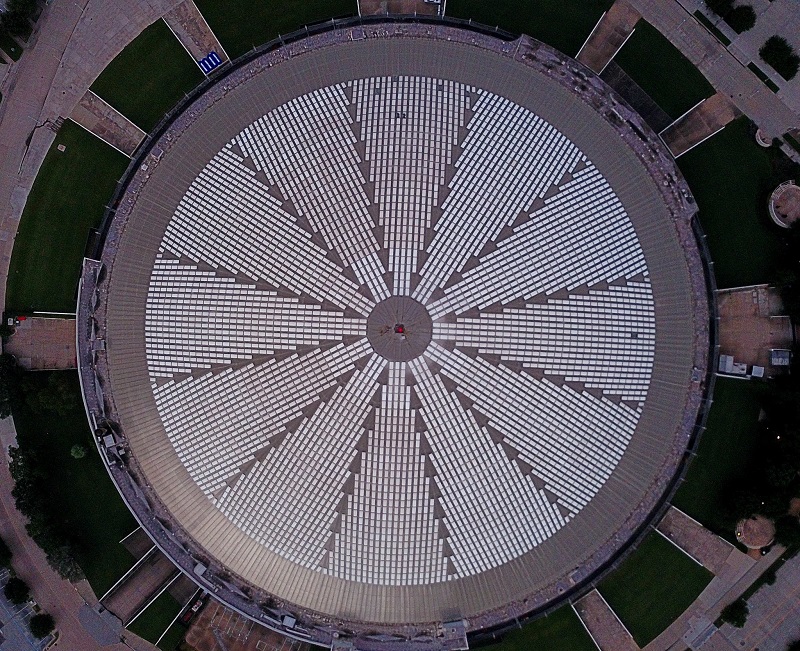BUILDING THE BIGGEST LIVING ROOM IN THE WORLD  From the prologue to The Astrodome: Building a Domed Spectacle, James Gast’s just-published history of the origins of the Harris County Domed Stadium: “The Astrodome is not a distinctive work of architecture. It is certainly not a bad building, nor is it an exceptionally beautiful one. The Astrodome ended its days as a major league venue in 1999, but it remains a uniquely influential building. On the simplest level, it changed the game of baseball and — in the opinion of legions of self-described purists — not for the better. If you happen to be a student of the game, you know that the artificial turf first introduced at the Astrodome changed the way baseball was played, placing a new emphasis on speed and spawning a generation of light-hitting speedsters playing on artificial turf fields with deep fences.
Off the field, the Astrodome’s creature comforts and barrage of electronic media forever changed the way the game is viewed. The Dome rose alongside the growing influence of television, and stood as a response to a commercial threat posed by television. To lure paying customers away from their TV sets and into the ballpark, stadiums needed to deliver comfort and amenities on par with the spectators’ living rooms. The Dome competed with television by emulating it: a comfortable seat, good food, and frequent electronic distractions. If, while at Phoenix’s Chase field, you find yourself engrossed in a video on the 6,200-square—foot high-definition scoreboard while enjoying curried chicken tacos with mint-marinated cucumbers and yogurt on top of scallion pancakes, you can thank — or curse — the Astrodome.” [Astrodome Book]
From the prologue to The Astrodome: Building a Domed Spectacle, James Gast’s just-published history of the origins of the Harris County Domed Stadium: “The Astrodome is not a distinctive work of architecture. It is certainly not a bad building, nor is it an exceptionally beautiful one. The Astrodome ended its days as a major league venue in 1999, but it remains a uniquely influential building. On the simplest level, it changed the game of baseball and — in the opinion of legions of self-described purists — not for the better. If you happen to be a student of the game, you know that the artificial turf first introduced at the Astrodome changed the way baseball was played, placing a new emphasis on speed and spawning a generation of light-hitting speedsters playing on artificial turf fields with deep fences.
Off the field, the Astrodome’s creature comforts and barrage of electronic media forever changed the way the game is viewed. The Dome rose alongside the growing influence of television, and stood as a response to a commercial threat posed by television. To lure paying customers away from their TV sets and into the ballpark, stadiums needed to deliver comfort and amenities on par with the spectators’ living rooms. The Dome competed with television by emulating it: a comfortable seat, good food, and frequent electronic distractions. If, while at Phoenix’s Chase field, you find yourself engrossed in a video on the 6,200-square—foot high-definition scoreboard while enjoying curried chicken tacos with mint-marinated cucumbers and yogurt on top of scallion pancakes, you can thank — or curse — the Astrodome.” [Astrodome Book]





The Dome DID change how baseball is played: in an enclosed venue,on FAKE plastic “grass”, with TONS of A/C ; while fans drank ok beverages, ate crappy “food” and were slightly distracted by electronic media. In that sense it was influential. { Footnote / behind the scenes true fact(s): Roy Hofheinz ( then the official “leader” of Harris County government ) started trying to hog all of the local/regional/national media spotlight ,while snubbing his benefactor – the very wealthy & powerful oilman /developer/real estate mogul R.E. (Bob) Smith ;Mr.Smith withdrew his very influential financial and political support from Mr. Hofheinz. Their partnership soured,to say the least . } Other covered ( and in some people’s opinions better ) stadiums were built. The Astrodome was the prototype and the first of its kind in the USA . That is part of Houstons history ,which NO other US city can trump. Later in the 1970’s Mr. Hofheinz,who was a risk taker ,lost control of his Astrodomain holdings (to ,if I recall correctly, the Ford Motor Company Credit subsidiary (which carried the financing of the Astrodomain properties). Mr.Hofheinz couldn’t keep up the payments and he desperately tried to come up with ways to refinance the holdings ,but couldn’t . He lived for a while in the penthouse suite of the then Astrodome Hotel (facing Loop 610 just west of Kirby-it’s a mish mash of styles straight out of the 1960s’- I was given a tour in the 2000’s.It is very reminiscent of 60’s Vegas high roller suites.It has a cool retro vibe. I think it is now called the Crowne Plaza Hotel Houston-Kirby Drive.
Are those guys pointing pistols at the ground, instead of the customary shovels?
The sign is reusable; just add an O – doomed stadium
I just finished this book and thoroughly enjoyed it. Those are guns in the photo – Colt .45s, in fact, loaded with blanks and used to ceremonially break ground. The book is well written and well researched. Now I’m pining for the those halcyon days in the mid 90s when 2,000 baseball fans and I could crowd around the plastic field and enjoy a game in peace.